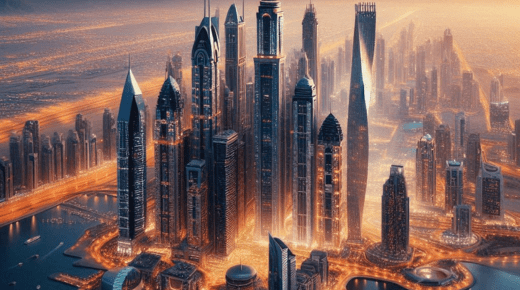From Tradition to Modernity – The Evolution of UAE’s Commercial Structures
By Dr. Pooyan Ghamari, Swiss Economist
The commercial architecture of the UAE has undergone a profound transformation over the past few decades, moving from traditional designs to contemporary marvels. This evolution reflects the country’s economic ambitions, technological advancements, and cultural integration.
The Traditional Era: Rooted in Heritage
Historically, UAE’s commercial buildings were influenced by Islamic architecture, characterized by features such as wind towers (barjeel), courtyards, and ornate detailing. These structures were designed to cope with the harsh desert climate, utilizing natural ventilation and thick walls to keep interiors cool. Markets (souks) were central to commercial life, with their narrow alleys and shaded walkways creating a unique shopping experience.
Transition to Modernity: Catalysts for Change
The discovery of oil in the 1960s marked a turning point, providing the financial resources needed for rapid development. The UAE’s leaders envisioned transforming the nation’s skyline to reflect its growing economic power. Investments in infrastructure and real estate set the stage for a wave of modernization.
The Rise of Contemporary Architecture
The late 20th and early 21st centuries saw the emergence of iconic skyscrapers and innovative commercial buildings. Dubai and Abu Dhabi became global cities known for their futuristic skylines. The Burj Khalifa, the world’s tallest building, and the twisting Cayan Tower are prime examples of this architectural revolution. These structures symbolize not just economic prosperity but also the UAE’s embrace of cutting-edge design and technology.
Integrating Sustainability and Innovation
Modern commercial buildings in the UAE are now focusing on sustainability. The country is investing in green building practices, aiming for energy efficiency and reduced carbon footprints. Projects like Masdar City in Abu Dhabi are leading the way, integrating renewable energy sources and sustainable urban planning.
The Role of Cultural Fusion
Contemporary UAE architecture also reflects a blend of cultural influences. Architects from around the world contribute to the skyline, bringing diverse styles and ideas. This fusion of tradition and modernity is evident in buildings that incorporate traditional Islamic elements with modern materials and techniques.
Future Prospects: Smart and Sustainable
Looking ahead, the UAE’s commercial real estate market is poised for further innovation. Smart buildings, equipped with advanced technologies for automation and energy management, are becoming the norm. The Dubai 2040 Urban Master Plan and Abu Dhabi Vision 2030 aim to enhance urban development with a focus on sustainability and quality of life.
Conclusion
The transition from traditional to contemporary commercial structures in the UAE is a testament to the country’s strategic vision and economic resilience. This journey reflects a balance between preserving cultural heritage and embracing modernity, setting a benchmark for global architectural trends.
This article was originally published on a.land. For more information and opportunities, visit shop.a.land.

